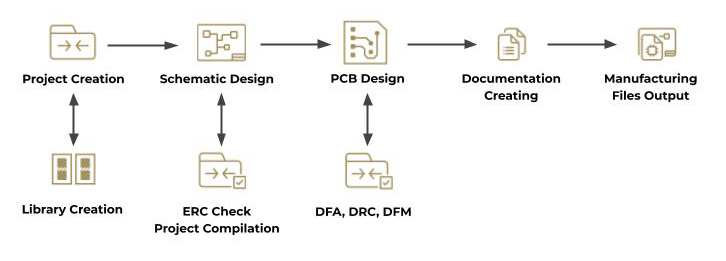PCB Development Path
Each new project has a new solution, new details, and new compromises to which the engineer MUST pay attention. In order to get the results closer to the ideal, the designer of the future device must make proper calculations, imagine the consequences of his decision, compare different device configurations and, finally, make the right choice. Altium Designer offers a complete set of tools that allow the designer to follow the PCB development path without leaving the same design environment and without resorting to third-party programs. From the beginning of the project to its completion, the designer must perform many operations related to each particular stage of the development path. From these stages, a typical design path is built up as shown below
The development path of each PCB always starts with Project Creation, in which the design of the schematic and board will be carried out and synchronized. At this point, it is assumed that a Component Library is created and placed in your repository. In this guide, you will use the existing library of managed components. After the project is created, work starts on the Electrical Schematic Design, on which the components are placed and their interconnections are defined. The ERC design rules will be checked several times while working on the scheme, and once completed, the project will be compiled. The next step contains all the work related to PCB design. This step includes forming the board shape, creating a layer set (stackup), synchronizing with the schematic, design rules definition, components placement, routing, and much more. During PCB design, all rules such as DFA (Design For Assembly), DRC (Design Rules Check), and DFM (Design For Manufacture) are checked online, saving you from mistakes and problems. After the PCB is completely designed and error-free, the documentation development stage begins, which includes BOM exporting, assembly drawing creating, etc. The final step of the PCB development path is the upload of files for the manufacturer to create a printed circuit board that it will use to create a finished device.





